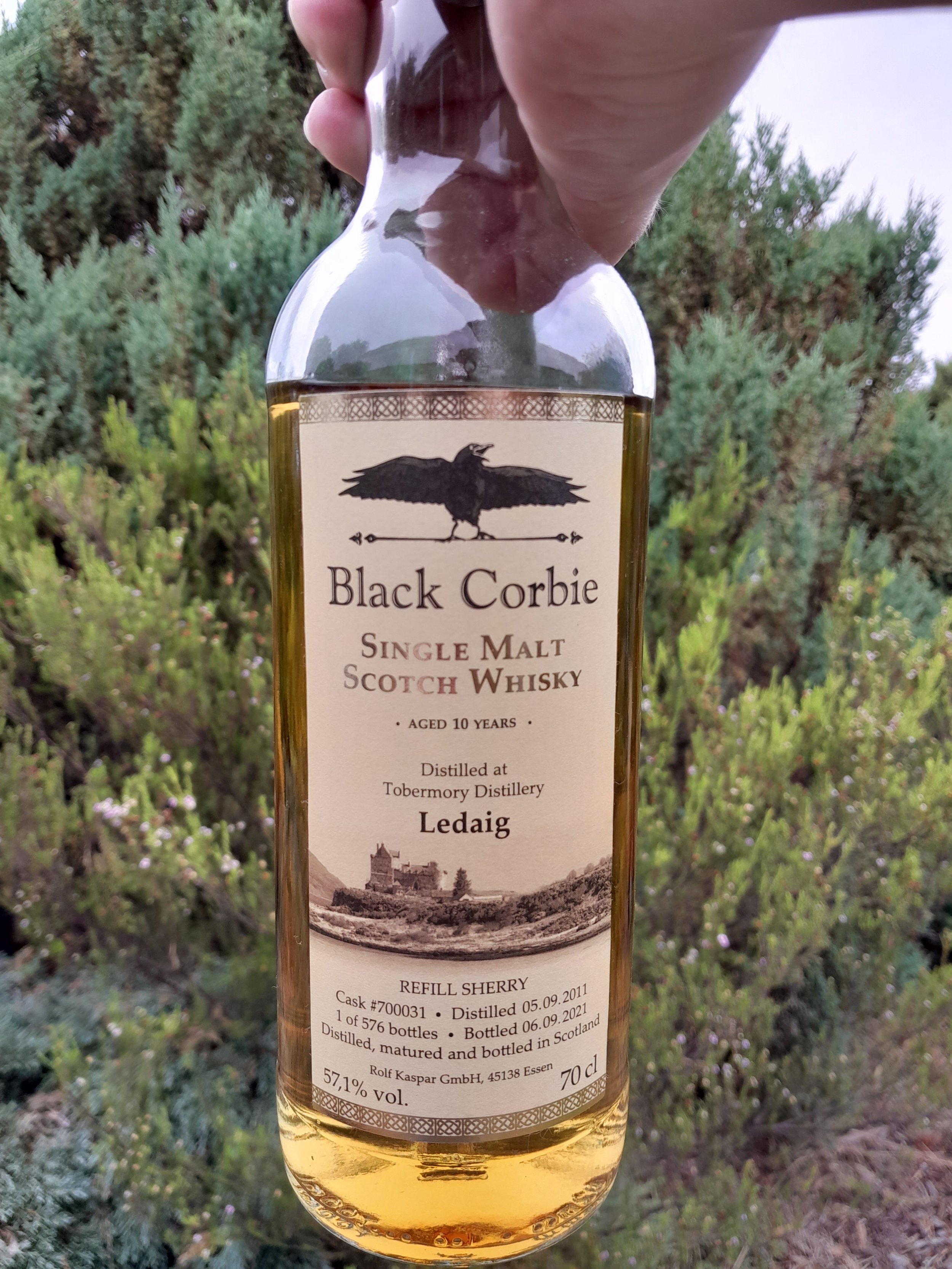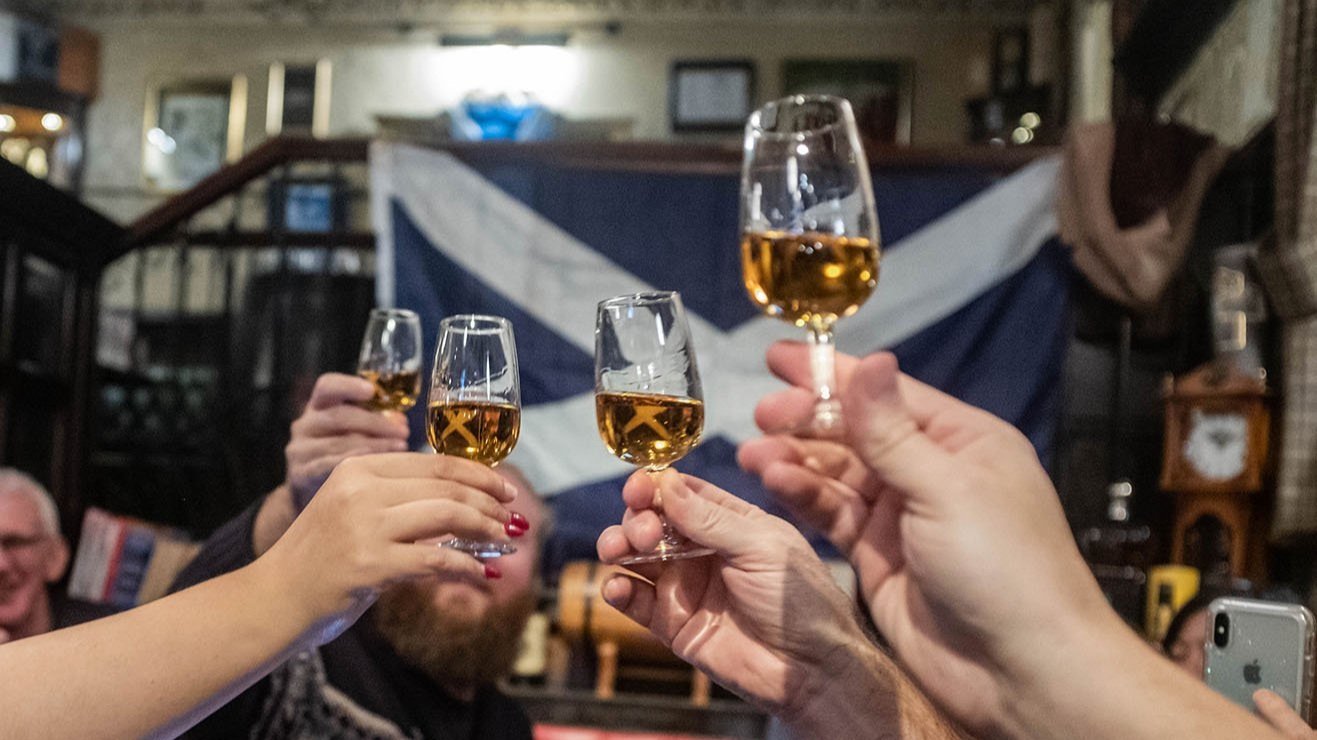Ledaig 10yo Black Corbie
2011 - 2021 | 57.1% ABV
Score: 7/10
Very Good Indeed.
TL;DR
This Ledaig is good, but hold the salt
Can we taste salt in whisky?
I think it’s finally time to tackle one of the most heavily debated topics in scotch short of using the dreaded terroir; can we taste salt in whisky?
Well much like our scores here on Dramface, rather than tease it out or force anyone to scroll to the bottom of the article, I’ll stick it right here at the front: No.
Technically there can be salt in whisky (is that the world’s quickest ever backpedal?) but we’ll get to that below. The main point of this article isn’t actually to address the lack of salt in whisky, which is usually pretty self-evident, but rather to explain why we might think we taste salt in whisky - those are two tremendously separate things.
So, first thing’s first; let’s dispense with the myth that whisky is salty. I suggest this article - from all the way back in 2003 mind you - as background reading on the subject, but I’ll surmise the key points.
According to the article, the common use of salt as a descriptor in whisky wasn’t really popularised until after it was proliferated by Michael Jackson, following his adoption of the term from a 1978 tasting panel’s description of Old Pulteney as the “Manzanilla of the North”. Since then the descriptor has rung true enough for a simply incredible number of punters, reviewers and production workers alike.
The article also references this study from the University Of Aberdeen to establish salt concentrations in whisky using triplicate analyses from a sample size of 31 commercially available scotch whiskies. The results of the testing gave salt concentration ranges between 3-23 mg/L of sodium; well within the boundaries for sodium content from non-ion-filtered dilution water. For reference, the government imposed upper bound for Scottish tap water is 200 mg/L sodium. Assuming similar, perhaps even higher limits for surface and ground water sources used by distilleries’ dilution water this seems reasonable.
whisky in salt, not salt in whisky. Credit: Hawkhead
If you’ll allow some quick Fermi approximations, then considering the whiskies were likely low ABV (40-46% by vast majority) the level of dilution from average still strength (about 70% ABV, depending on distillery process) to cask filling strength, say 5-10% ABV angel’s share for varying ages of stocks, and then from cask strength to bottling strength would be in the order of roughly 20%-35%, ie roughly ⅕-⅓ factors. These factors applied in reverse for sodium content are then consistent with the allowable levels observed with dilution water.
To give context for these figures, the lower bound for sensory detection of salt according to the malt magazine article is about 160 mg/L sodium- a full order of magnitude greater than the median value measured in the commercial examples. Through a cursory scan of some literature (such as this study on salinity in water, wine and must solutions) the mean data reinforces this figure as a lower bound for the detection threshold.
At any rate, we should also observe that the levels of sodium measured between the 31 samples follow no trends between distillery and/or maturation locations and the relative position of the coastline. In fact the top five concentrations belong to, in descending order; Glenfarclas, Bruichladdich, Jura, Aberlour and Lagavulin.
Now, I admit to having next to no knowledge of botany, so any botanists out there please feel free to correct any errors in the following; oak is a semipermeable storage device allowing volatile gases such as ethanol and water vapour to pass through its structures at a very slow rate by way of diffusion. To the best of my knowledge (and brief research) there are no passive ion channels in the structure of oak allowing for sodium to permeate casks. While oak trees move ions like potassium and magnesium through vascular structures to leaves where they are used for metabolic processes such as creating chlorophyll in the tree’s leaves, these processes (again, to the best of my research) only occur through active/energy consuming processes in live tissues. Sodium can move similarly in live trees, though it is a poison to oak as with the vast majority of other deciduous species. Thus, it is usually found in low concentrations in oak wood where the majority of the trees used in the various drinks industries are grown. Regardless of the mechanisms being debated, the fact remains that we do not see any significant reports of salt in whisky from distilleries or research labs by means of chemical analysis, so any argument to the contrary lacks the causal outcome.
Damningly supportive evidence for salt’s lack of oak permeation, though it is circumstantial correlation and not necessarily causation, is the observed “salty qualities” in whiskies which are not matured anywhere near the coast. Most will know that companies like Diageo and Distell use centralised warehousing for their malts (such as Caol Ila, Ledaig and Talisker to name but a few) on the mainland, and that new make is generally taken from spirit receiver vats and pumped into tanker trucks before being shipped from their source distillery to the mainland, then filled into casks in said warehouses. There is thus no chance for a coastal environment to impart influence on these whiskies anywhere during maturation.
Long story short, there is just no provable correlation between a distillery’s geography and the observed concentration of salt in its whisky. The only serious scientific argument that a distillery could posit is that their coastal geography increases the salinity of a water source used for diluting whisky from still strength to cask strength and/or from cask strength to bottling strength. As has been shown with the data from the above Aberdeen university study, this doesn’t appear to be the case, certainly not to the degree that organoleptics are affected.
In all fairness to the “salty” descriptor, I used the term too for a long time before doing some research and establishing that it was not an adequately precise term for what I meant to construe. On face value, it communicates the idea that a whisky might be coastal or otherwise marine and is thus used synonymously with terms like fish/shellfish, crustaceans, seaweed and generally the ocean. It might also be used to implicate foods and drinks which are dominantly salty such as olives, capers and salt-cured meats. In this sense it’s a nice shorthand for condensing meaning into a succinct package. Much like other forms of compression though, data is usually lost in the process, and in this instance critical accuracy is lost.
So if it isn’t salt causing sensation, what might we be detecting?
Well, as I’ve touched on in this feature article, there are elements of whisky which replicate coastal qualities we associate with salt. A quick Google search will reveal that the three major smells of the ocean are contributed by DMS, dictyopterenes and bromophenols. Bromophenols have a well documented presence above their detection thresholds in whisky, particularly in coastal whiskies, especially in those using coastal peat. In fact, between 20-600 times higher concentrations than their detection thresholds in water according to my copy of Whisky Science.
Components from malt, fermentations and peat can contribute DMS and other polysulfides with similar organoleptic properties. DMS and polysulfide levels are reduced by copper reactions in the stills and condensers, and levels generally drop sharply in the first few years of maturation, as do many polysulfides due to sorption with oak and gradual volatilisation through oak to the outside environment. However, their extremely low smell detection thresholds (for instance, about 30 ppb for DMS and 4 ppb for DMTS) mean they frequently contribute to the aroma and taste of whisky.
As I touched on above, we might also find some of the smoky, maillard and sulfur flavours we associate with salty bacon and superimpose that on our whisky tasting. Pyridines contributed by peat and other sources can also contribute fishy/amine notes which we might associate in a Pavlovian manner with coastal saltiness. On that note, a fun fact about the oddities of organoleptics; oysters and fresh fish emit volatiles like hexanal, which is a “Green leaf volatile” (GLV) which can be grassy and fresh, and nonenal which contributes to the aroma of cucumbers and watermelons. These aldehydes can also be found in fermented products such as whisky. It just goes to show that although one might observe great biodiversity, many metabolic processes yield very common volatiles which we might recognise in all manner of scenarios and ascribe as varying characteristics depending on circumstance.
Lastly, there are aspects of whisky that can emulate how our body reacts to salt; both cause our salivary glands to excrete saliva to dilute the contents of our mouths and increase taste sensation. The prickle we get across our tongues when sipping whisky, particularly at higher strengths, is not dissimilar to the mouthfeel and palate texture we sense when eating a food coarse with salt crystals. Many tasters equate this sensation to a pepper or chilli heat, which is perhaps an indicator of a mild pain response, but the actual textural sensation is, I would argue, closer to what we experience from salt.
One might comment at this stage that just because we don’t literally find salt in whisky is no good reason to stop using it as a descriptor; after all, we don’t actually taste the presence of grapefruit, liquorice or any number of other items in whisky do we? It’s a fair retort, and completely valid - reviewing whisky is a subjective and ridiculously non-scientific process in most instances. The only objective way to taste whisky is to list the chemicals one might suspect are present and then check to see if they are with analysis!
The difference though, I would argue at least, is this - while we might not taste the literal presence of any of these other things in our whisky, we do literally taste some of the same chemicals present in those things that give them their flavour, as has been the subject of much of my previous writing here on Dramface. The same cannot be said with any credible evidence for salt.
Review
Black Corbie Ledaig 10yo, 2011- 2021, 57.1% ABV
AUD$200 (AUD$170 paid)
As with my Signatory Ledaig review, this bottling ticks a lot of boxes on paper. It’s admittedly on the younger side, but as with many peated styles that can be a great advantage for displaying distillery characteristics. Also like the Signatory, it’s spent its full maturation in a single refill sherry cask and the number of bottles in the batch would indicate that the cask was probably a butt; we should thus expect a fairly balanced cask influence for the age.
As with any sherry cask there’s the risk of sulfur taint, but the precautionary review skimming for this on whiskybase didn’t indicate any obvious issues. Without any further ado, let’s see what the deal is.
Nose
The cask seems clean, at least to the degree that it’s the Ledaig funk which dominates. Starts with spirit sulfur a la fish sauce with some soy sauce thrown in the mix (likely aided by the sherry influence) with a touch of cigar wrapper and cereal-rich silage sweetness. The youth is moderately demonstrated by a slight acetic zing, though that’s all but forgotten behind the wave of coastal peat; some medicinal cresols and shellfish-esque brominated phenols layer over citrus oils, thymol and similar terpenes chased by beach-bonfire smoke, new bitumen and just a touch of hot plastic. The cask is subtle indeed, but just a hint of ginger and vanilla dance peripherally.
Palate
More funky/umami fish and soy sauces, plus a touch of balancing sherry sweetness that comes off like hoisin sauce. Mild rice vinegar and all manner of pyrazines, terpenes and related benzenoids - galangal, unripened lime, red chillies, liquorice, sichuan pepper and tobacco among them. The peat continues directly from the nose but with pronounced barnyard phenolics, then dilution (about 10% by volume) unlocks some creosote and ash while restricting the acetic components and developing a few dried stone fruits, though the sherry influence continues to be globally autolytic/oxidised. A nicely subtle vanilla and coconut oakiness emerge through the finish.
The Dregs
Much like the Signatory, this bottling makes wonderful use of refill sherry to complement and augment the funkier aspects of Tobermory’s peated distillate, yet avoids subduing any of the brilliantly diverse spirit characteristics. Admittedly there is a bit more youth here than in the Signatory, though as I’ve expressed before that’s hardly an issue for my preferences - the new-make elements have functionally dissipated, so I’m a happy camper. Overall I think the Signatory is probably a slightly richer dram with a bit more sherry influence and the correspondingly more intense sweet/savoury peat interplay, however this BC is such a fresh, nuanced and terpenic bottling. I’m glad to have both in the collection, and though I’m not quite scoring it the same as the Signatory this knocks in at a high weight for its class. At the UK price it’s a tad stern, but at the price I paid it knocks on the door of eight-dom.
Score: 7/10
Tried this? Share your thoughts in the comments below. TK
-
Dramface is free.
Its fierce independence and community-focused content is funded by that same community. We don’t do ads, sponsorships or paid-for content. If you like what we do you can support us by becoming a Dramface member for the price of a magazine.
However, if you’ve found a particular article valuable, you also have the option to make a direct donation to the writer, here: buy me a dram - you’d make their day. Thank you.
For more on Dramface and our funding read our about page here.











































